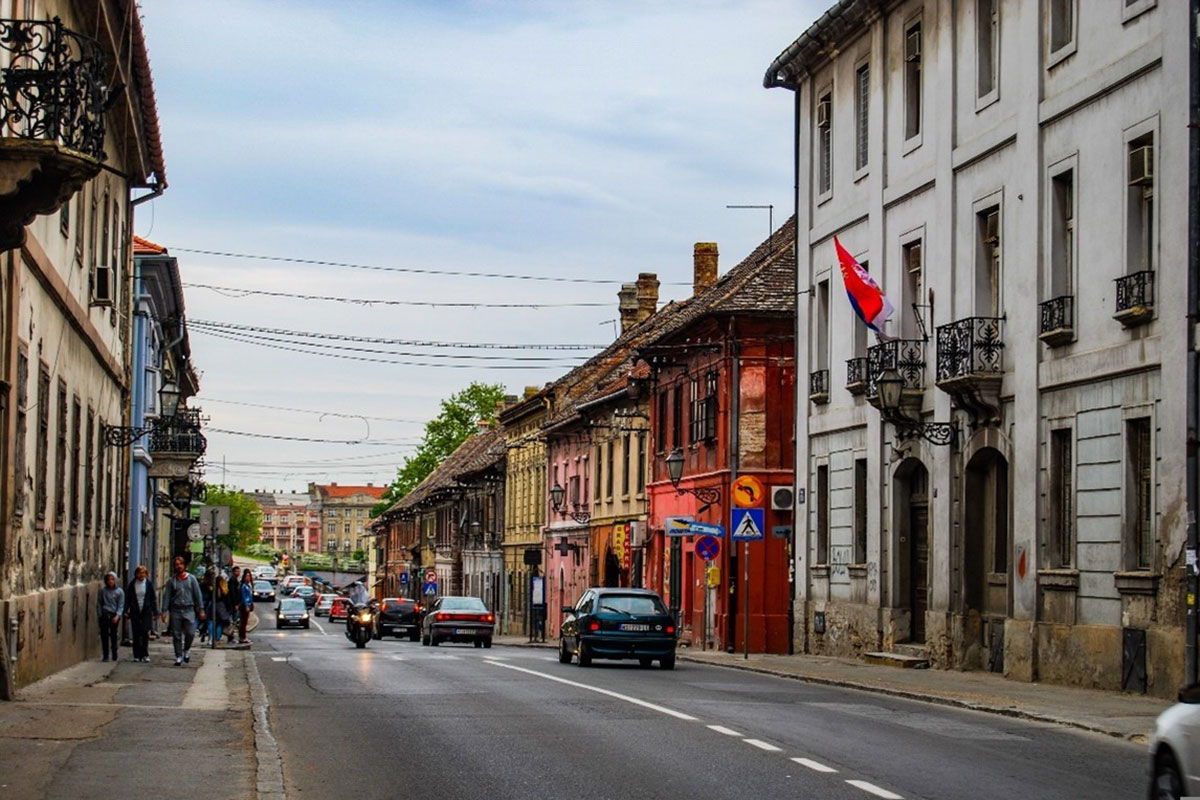The fact that the last 50 years have seen a temperature rise of 0.5 degrees per year, as indicated by the measuring stations outside the cities, and such a trend is also recorded in the cities, has minimal impact on those in charge of urban development planning. Profit, however, seems more real and tangible.
It was one of the first hot days in June this year in Novi Sad. In the park behind the Rectorate of the University of Novi Sad, where Prof. Dr. Stevan Savić and his colleagues parked a mobile station for measuring temperature and other parameters, it was really tolerable (if the mosquitoes don’t count!); if you stepped out of the shade of the numerous poplar trees it was, to put it mildly, unbearable.
Dr. Savić is a full professor at the Department of Geography, Tourism, and Hotel Management (Department of Geoecology) of the Faculty of Sciences in Novi Sad, and his field of scientific research is urban climatology.
"To put it in simple terms, the urban climate is the climate of cities, which is actually a modified climate in relation to the natural environment," as this urban climatologist explained to me.
Although this park on the university campus is one of the few parks in Novi Sad, it has no guarantees of surviving with the dimensions it currently has.
While Professor Savić was telling me about the rising temperature in the city, I kept thinking about the fact that Novi Sad has lost seven parks (!) and large green areas in the last five years through changes in the planning documentation. The reason for this - clearly - is the construction of new residential complexes and business buildings.
Novi Sad is not only facing the consequences of climate change, which is a global phenomenon but also the unreasonable moves of the city authorities, which make the life of citizens in the second largest city in Serbia increasingly difficult to bear.
Especially in the summertime.
In recent years, during pronounced heat waves, between the most urbanized areas in Novi Sad and the natural areas around the city, the difference in temperature, especially at night, can get between eight and ten degrees, Professor Savić told me.
The increase in temperature in cities, he added, is a consequence of increasingly intensified urbanization, while climate change only further contributes to the increase in temperature on a global level, and also contributes to even higher temperatures in the cities - primarily due to the combination of artificial surfaces and tall buildings.
And the increasingly obvious lack of green areas.
"In Novi Sad, the number of green areas has significantly decreased. There are green areas left along major roads and infrastructure corridors and some parks that we can count on two hands, while, for example, Vienna alone has several hundred parks," Ana Ferik-Ivanović, president of the Association of Architects of Novi Sad, remarked.
This spring, just at the time when the city conducted a brutal saw attack on the precious green oasis on the banks of the Danube, the same city, which, according to the research of the "Let's Reforest Vojvodina" Network, is in ninth place in terms of forest area (in hectares), and in 12th place in terms of forest area density among the cities and settlements in Vojvodina - in the least forested region in Europe! - deserved the title "European City of Forests"!? Just how much should a city screw up to be left out of the competition with the acquisition of such a title?!
That oasis, Šodroš, the "lungs of the city" and habitat of numerous species of birds, suffered a great deal of destruction due to the announced construction of a new bridge over the Danube - for now, it is estimated that around 50 trees have been cut down, and it is certain that the felling will continue when the work on bridge starts - by the same people who will boast with the title "European City of Forests" throughout this year.
The environmentalists who camped for months in an effort to defend Šodroš showed perseverance - just like the city authorities in their intention to prepare the ground for the construction of the bridge (which, as it is claimed, is a "Trojan horse" for the construction of a new million square meters of apartments and other premises into the project colloquially called "Novi Sad on water"!).
If the city fathers have no problem cutting down the forest, why would they have a problem with giving investors a project in which greenery, best-case scenario, only exists on paper? As well as parking spaces.
Despite the fact that the urban area of Novi Sad today has at least 100,000 more inhabitants than 20 years ago, and in terms of the number of those who immigrate to it, it is the only one that can match Belgrade, the once peaceful town in Vojvodina "offering excellent living conditions" has been transformed in the last decade into a city from which one escapes whenever the opportunity arises; at least for the weekend, mostly on Fruška Gora, which, again, is rapidly losing its age-old status as a dense and rich forest; forests, under the auspices of the state and the SPC, are being ruthlessly cut down.
 Source: pixabay.com
Source: pixabay.com
Overpopulated, with a traffic infrastructure that is increasingly difficult to cope with the drastically increased number of cars, while the outdated communal infrastructure has no capacity for more and more new buildings and new residents; with polluted air for a good part of the year, with high summer temperatures and surrounded by concrete on all sides, Novi Sad still offers people what their home environment, which is far healthier to live in, does not offer: some kind of perspective.
Life in Novi Sad thus became clearly worth enduring, like a form of masochism. Politicians view this through their lens and proudly point out that the city has been a "big construction site" for years.
What is the volume of residential construction in Novi Sad? In addition to the nearly 200,000 existing housing units, in 2022 the construction of around 10,000 more apartments was underway - in that year alone, work on around 3,500 apartments started.
Urbanization in Serbia in the last fifty years has led to a significant increase in the percentage of constructed areas in cities - from 1.06% of the total area under buildings in 1975 to 1.97% in 2014, as was pointed out by Prof. Dr. Slobodan Milutinović, full professor at the Faculty of Occupational Safety and Health in Niš, whose narrower field of interest is urbanization and sustainable urban development.
At the same time, less and less attention is paid to green areas.
"Compared to European cities, cities in Serbia have an almost negligible amount of total green space in relation to the total urban area. For example, Stockholm and Frankfurt have 68% and 52% of green areas, respectively, while Kragujevac and Subotica are barely at 5%. The plan for the general regulation of the green area system for Belgrade, adopted in 2019 as part of the 'Green regulation of Belgrade' project, foresees an increase in the area covered by greenery (forests and public green areas) from the current 12.38% to 22.74%. However, regardless of statistical data, practice shows that green areas are not a priority of city authorities in this current era of investor urbanism. Plans for creating new green areas, although they exist, are not implemented, and the existing green areas are fragmented and poorly maintained or restored."
Aside from the importance of green infrastructure for recreation, children's play, or the aesthetic and spiritual experience of urban space, greenery in cities is, Professor Milutinović points out, an important catalyst for local climate and air pollution levels.
"In the conditions of extreme temperatures and heat waves to which we will be exposed more and more, the temperature in the shade is significantly lower and it is more pleasant in shaded areas than in the open air." Due to infiltration into the soil, greenery enables better regulation of precipitation runoff and, therefore, prevents the negative impact of extreme precipitation and better treatment of wastewater. Green areas are particularly important in cities that, due to the slope of the terrain or the character of the soil, have problems with erosion and landslides: green areas prevent soil erosion and prevent landslides. Finally, green areas create the conditions to support ecosystem services in cities, including biodiversity, biological protection, and pollination."
"Cure is better than prevention"
Precipitation runoff. This is the term that the people of Novi Sad became painfully aware of in May of this year when in ten minutes an enormous amount of rain fell on the city, which caused the streets in a good part of the city to be flooded, although that was not the first instance in the last few years.
Despite fairly clear warnings that more and more extreme weather events await us in the future, Novi Sad’s Mayor Milan Đurić did not think it is wise - moreover, that it is not profitable - to invest in strengthening the capacity to absorb so much water, so he succinctly concluded that it is more worthwhile to – compensate the citizens for damages!
Such extreme rainfall, which recently led to floods in many areas in Serbia, is an effect of climate change, according to Professor Milutinović, and in such conditions the existing infrastructure for the drainage of atmospheric wastewater - designed for some other, milder conditions - is not able to take in the runoff, resulting in floods. The problem, this expert pointed out, is that this infrastructure is still being designed for the rainfall conditions we had when climate change was not as extreme.
"Another big problem is the paving of cities with a waterproof surface. More asphalted, concrete or paved surfaces mean a lower possibility of atmospheric precipitation infiltrating the soil and thereby reducing the pressure on the infrastructure for draining atmospheric waste water," Professor Milutinović pointed out.
In Serbia, at least, one does not get the impression that the consequences of drastic changes in the global climate and even the climate in the cities are of serious concern to anyone, although they are already reflected in the quality of life and the health of the population.
Urban climatology, an area that Professor Stevan Savić studies, should serve public health in a way that scientists’ proposals are used to improve the situation so citizens can better adapt to the new climatic conditions.
Research can show urban planners and local authorities where they are going wrong with urbanization, noted Professor Savić, who admitted that he doesn't really have a positive experience with it.
"The mistake is the large concentration of very tall buildings in a very small space," Professor Savić pointed out, "and you need to know exactly how to fit the combination of green and built-up areas in order to get the optimal temperature."
Professor Slobodan Milutinović stated that the Ministry of Environmental Protection has prepared a draft of the National Plan for Adaptation to Climate Change, which is in the process of public discussion. A number of local governments have also adopted local adaptation plans. However, Professor Milutinović noted that these plans are not being implemented. A good example of this is the adaptation plan to the changed climatic conditions for the City of Belgrade, which was adopted in 2015 and was never implemented.
"By signing the Sofia Agenda, Serbia undertook the obligation to implement the EU's Green Agenda, which, among other things, includes the development of green and climate-responsible policies. In my opinion, the biggest problem is the insufficient awareness of public policy makers about the necessity of looking at all public policies through the prism of mitigation and adaptation to changed climate conditions."
Adopting various acts and documents is one thing, but accepting climate change, in reality, is obviously something completely different. Even the fact that, as Professor Stevan Savić pointed out, in the last 50 years the temperature has increased by 0.5 degrees per year, as was indicated by the measuring stations outside the cities, and such a trend is also been recorded in the cities themselves, has a negligible impact on those who plan the development of cities. Profit, however, seems more real and tangible.
If it were not so, I guess the institutions in Novi Sad, especially the utility company, which must respond first in case of floods in the city, would have accepted the gift of Professor Savić and his colleagues who provided through a project a network of 15 precipitation stations plus a system for early warning of floods.
Nobody cared. The faculty maintained that equipment for as long as it had the funds, and then, after 2-3 years, it had to shut it down. The same thing happened with the previous one.
The blog was created as part of the “Tales from the Region” initiative led by Res Publica and Institute of Communication Studies, in cooperation with partners from Montenegro (PCNEN), Kosovo (Sbunker), Serbia (Autonomija), Bosnia and Herzegovina (Analiziraj.ba), and Albania (Exit), within the project "Use of facts-based journalism to raise awareness of and counteract disinformation in the North Macedonia media space (Use Facts)" with the support of the British Embassy in Skopje.This edition of Tales from the Region is also done in partnership between ICS and the UPSURGE project, funded within the European Union’s Horizon 2020 under grant agreement No. 101003818.
Please refer to the Terms before commenting and republishing the content. Note: The views and opinions expressed in this article are those of the author and do not necessarily reflect the views of the Institute of Communication Studies or the donor.


